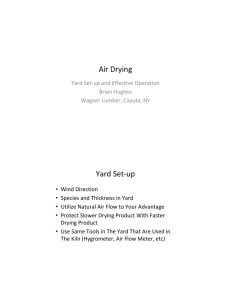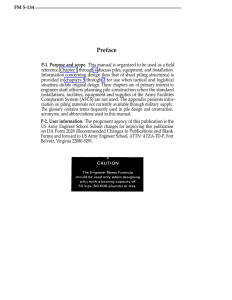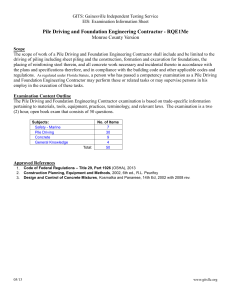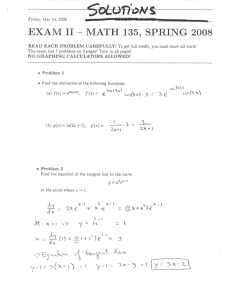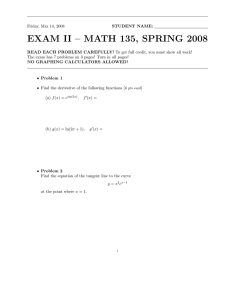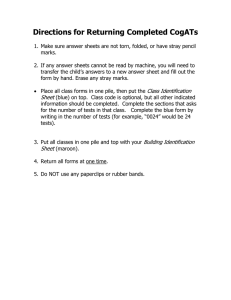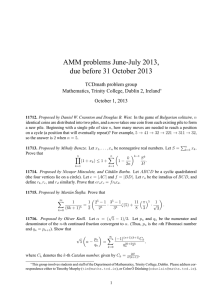PILING SOUTHERN YELLOW PINE LUMBER FOP AIR SEASONING
advertisement
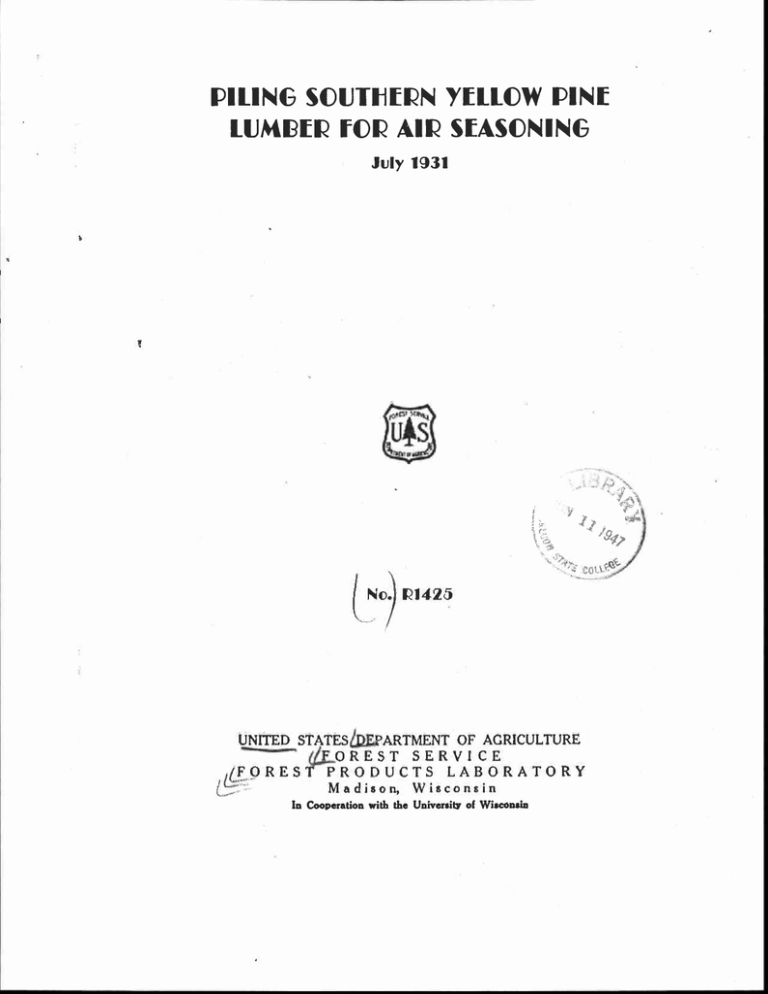
PILING SOUTHERN YELLOW PINE LUMBER FOP AIR SEASONING July 1931 o) 81425 N TOFAGRICULTURE UNITED STATES SERVICE PTM SE EST FOREST PRODUCTS LABORATORY Madison, Wisconsin In Cooperation with the University of Wisconsin PILING SOUTHERN YELLOW PINE LUI2ER FOR AIR SEASONING' By J. S. MATHEWSON, Senior Engineer INTRODUCTION The'purpose of this article is to outline the general principles underlying the proper methods of piling lumber for air seasoning and to apply them to southern yellow pine boards and dimension. Drying conditions vary from yard to yard. Since these conditions determine the exact method of piling that is proper, pile dimensions that are fine for one yard may cause heavy degrade in another. Local conditions always determine such details, for example, as the spacing between boards in the same layer; the operator, guided by the principles presented here and in other publications, must find out just the procedure that is best for the climatic and other conditions in and around his yard. To do so will require careful study. No instructions for general use can be definite about details that vary from place to place, and on the other hand no operator who lacks a grasp of the fundamental principles that apply to his problem can solve the problem correctly. A clear-cut instance of the effect of location on drying conditions comes from Florida. An operator there re ports that by moving his air-seasoning yard only half a mile the drying rate of the stock was increased about 30 percent. Obviously, if the drying time and the degrade had been satisfactory in the first yard a modification of the piling method would have been required to accomp lish the same results in the second yard. FU1 DAI1NTAL FACTS Some general - principles.--Two common seasoning defects that may cost heavily are checking and blue stain';' the first results from too much drying and the second from too slow drying. Consequently the p iling method to be adopted in a particular case depends upon which defect is causing the greater loss. Obviously the ease with which air can pass through a pile has a direct bearing on the drying rate. When • warm air comes into contact with green lumber the air gives up heat, come of which evaporates moisture from the:Wood. Since i giving up heat cools the air, it becomes heavier and_ its natural tendency is then to move downward. If rapid drying is desirable for the lumber in hand, the tendency of the cooled air to flow downward should be used by piling the boards with several continuous openings extending from the bottom to the top of the pile; such openings are called f lues. With even-width stock, doing 1Tublished in Southern Lumberman, July 15, 1931. :dines,. No. R11125 -1- this is comparatively simple. With random-width stock, it is necessary to pile edge to edge two or more boards whose combined width is about 12 inches and then to leave a flue space of 3 to 4 inches between this tier and the next one. Yard site.--The yard should be well drained and free from weeds and debris. General conditions in and around the yard should be examined closely; as a rule, neighboring trees or other obstructions to wind are undesirable, and' ordinarily adjacent water, with its resultant dampness, should be avoided wherever practicable. Alleys.--Main alleys should be from 16 to 20 feet widen rear alleys at least feet wider and cross alleys spaced 200 to 300 feet ap4rt, should be 60'feet or more wide, so that they may act as fire breaks. Tramways.--To facilitate the transportation and piling of.stock, elevated wood runways„called tramways, are':6 .omptimes built in the main alleys. Although the advantages of these structures are evident, it is well to recall also that 'the lOwer part of a pile next to a tramway is very likely to dry more slowly and consequently to stain much more than the rest of the pile. It is a question, therefore, whether their cost is justified, If conditions that necessitate the use of tramways seem to be incapable of change, the part of a pile below the level of the tramway should be more open than usual to permit better air circulation. One of the simplest ways of accomplishing this end is either to use thicker stickers or to dotible the stickers, that is, to use two 1-inch stickers instead of one 1-inch sticker to separate consecutive layers of stock. Foundations.--The principal requirements in satisfactory supports for a • • lumber pile . are firmness, durability, and a height sufficient to allow the air that has circulated downward through the lumber to escape readily; wind• from any direction should be able to get beneath the pile to carry away this air more quickly than it would move otherwise. ,The minimum distance between the ground and the first.layer of stock should be 18 inches. Firmness and durability are required to prevent sagging of the pile and consequent warping of the stock. Box piles.--Sometimes the separation of stock with respect to length is not feasible and the stock is then piled with overhanging ends, the usual result of which is an unnecessary amount of warping. If stock is piled without overhanging ends the method is called box piling. In piling random-length stock for air seasoning, the longest boards or planks should be-placed in the two outer tiers, and if there is a sufficient number of these boards for additional tiers, such tiers should bp uniformly distributed across the width of the pile. As far as possible the boards throughout any tier should be of the same length, whatever that length may be. In piles for air seasoning, whether the short boards should'all be placed. with their ends flush with the front face of the pile or whether adjacent short-board tiers should be flush with the front and the rear faces, respectively, depends on the stickering. Let us suppose, for example, that 12-foot and 16-foot boards are being piled and that three tiers of stickers are adequate for the 16-foot stock. If the Mimeo. No.. R1425 -2- short-length tiers of boards are all flush with the front face of the pile, one loss tier of stickers to support the ends of the 12-foot stock will be required than if the alternate method is used. On the other hand, if the number of interior 16-foot tiers is limited, saving one tier of stickers by such piling may result in too much sag in the rear tier of stickers, which will then themselves be unsupported over a wide span, and such sag is almost certain to deform the boards resting on them. If five or more sticker tiers are required to keep the 16-foot stock from warping, adjacent short-length tiers of boards should be placed flush with the front and the rear faces of the pile, respectively. Such staggering of the short-length tiers is also well adapted to a pile in which there are no interior long-length ones. Pile spacings.--The spacing between piles should not be less than 2 feet, and 4 feet is desirable. Pile widths.-- S quare piles of boards are rather common practice in the southern yellow pipe region, but some piles are only 6 feet wide; the object in narrowing the/ pile to this width is to increase the drying rate. With 2-inch and heavier stock, however, so narrow a pile may increase the checking. Pile pitch and slope.--The usual pitch of the alley is about ' 1 inch to the foot of height. rain to drip from the front face, so that the through the pile. The slope of the pile from to the foot of length, an amount that permits the top or from the sides to drain off. front face of a pile toward the Such inclination permits the water is less likely to trickle front to rear is usually 1 inch water entering the pile from Stickers.--The strips or boards used for separating the layers in a..pile are generally referred to as stickers and sometimes crossers. They are of two kindsf stock stickers and special stickers. As the name indicates,,,stock stickers are boards of the same kind as those being piled. Special stickers, on the other hand, may be of the same or of different species. _Stickers should preferably be heartwood and should always be dry. Where a wet sticker touches a wet board both pieces lose moisture very slowly, and excessive blue stain and checks, and uneven moisture content are likely to result. Hence stock stickers usually cost in degrade more than they save in sticker expense. The usual special sticker for southern yellow pine boards is 1 by 4 inches, although 1 by 2-inch stickers are sometimes used. Narrow stickers aid in reducing checking and strain. Wide stickers are objectionable also because the portions of a board in contact with them dry more slowly than adjoining portions. In one instance the moisture-content values were 17 and 23 percent, respectively, for two adjoining portions in the same 1 by 12-inch board that supposedly was 'seasoned. Incidentally, on the basis of the higher moisturecontent value, the board should have been lowered two grades. The stickers in the end tiers should be placed so that they project about half an inch beyond the ends of the boards, to reduce end checking. Each sticker tier should be supported by a foundation beam and should be parallel to the front face of the pile. Mimeo. No. R1425 -3- A starting point.--When an operator in southern yellow pine wishes to improve the piling in his yard and has little definite information on. dimensions to guide him, the following dimensions may be of service as a starting point: Width of pile Spacing of stiekerd Space between adjacent tiers of lumber 6 to S feet ,Not over 5 feet 2 to 3 inches Careful and frequent observation of the results of piling lumber this way will show to a qualified man what modifications of these general dimensions will be desirable for the conditions in his particular yard. These dimensions are simply a good first guess when nothing better is available and, although they will undoubtedly fit some yards in some size of lumber as they are, only proper observation of the results will tell just what dimensions are best for any given yard. afford protection against sun and rain some form of pile covering tRoofs.--To i—Tdvantageous. It may well consist of two layers of low-grade boards, the boards in the lower layer being spaced about half an inch apart and those in the upper layer being placed directly over these spacings. The roof should slope about 1 inch to the foot, should average about 5 inches above the top layer in the pile, and should extend about 1 foot at the front and 2-1/2 feet at the rear. FURTHER INFORMATION Seasoning.--Additional information concerning the seasoning of wood and related matters is given in the following bulletins of the United States Department of Agriculture, which may be purchased from the Superintendent of Documents, Government Printing Office, Washington, D. C., for the prices indicated: Technical Bulletin No. l74, "The Air Seasoning of Wood," 35 cents; Technical Bulletin No. 165, "The Kiln Drying of Southern Yellow Pine Lumber," 20 cents; Department Bulletin No. 1136, "Kiln Drying Handbook," 30 cents. Antiseptic dips.--Although careful attention to piling methods is beneficial in reducing blue stain, there are many cases in which a marked reduction in the occurrence of this defect can be more effectively accomplished by means of any one of several, chemical solutions now on the market. Detailed information concerning this subject may be obtained, on request, from the Office of Forest. Pathology, Southern Forest Experiment Station, 1000 FederalOffice• Bldg New Orleans, Louisiana. Mimeo. No. R1425 -4- Figure l.--Concrete piers, set at a depth sufficient to insure stability, supporting the stringers and beams of a pile foundation. Figure 2.--Concrete piers adequate in height and well-kept surroundings, as shown in the center of the illustration, make for excellent ventilation and tend to prevent loss from stain and decay. The low and solid foundations at the 2 M 45747 F right are in marked contrast.
